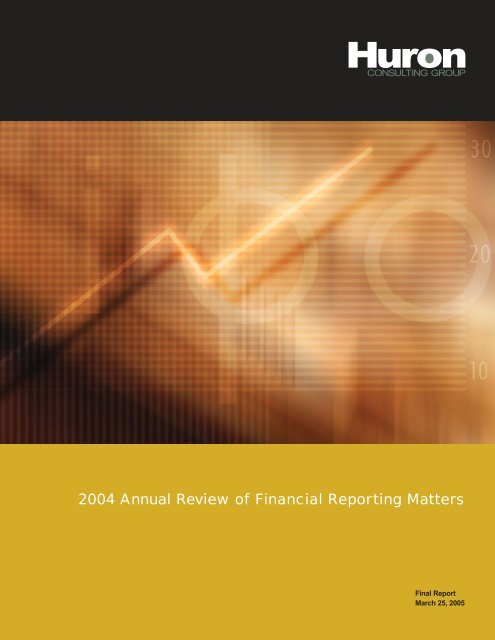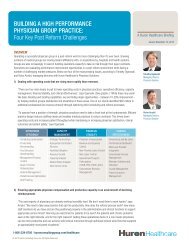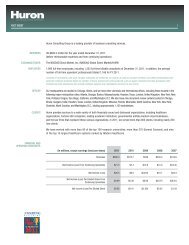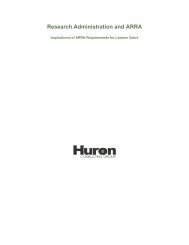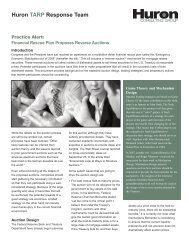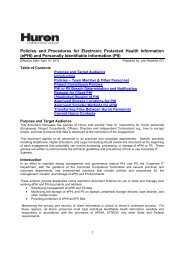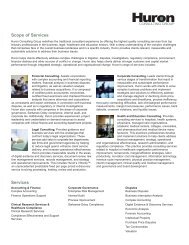2004 Annual Review of Financial Reporting Matters - Huron ...
2004 Annual Review of Financial Reporting Matters - Huron ...
2004 Annual Review of Financial Reporting Matters - Huron ...
You also want an ePaper? Increase the reach of your titles
YUMPU automatically turns print PDFs into web optimized ePapers that Google loves.
<strong>2004</strong> <strong>Annual</strong> <strong>Review</strong> <strong>of</strong> <strong>Financial</strong> <strong>Reporting</strong> <strong>Matters</strong><br />
Final Report<br />
March 25, 2005
<strong>Huron</strong> Consulting Group is proud to<br />
present its <strong>2004</strong> <strong>Annual</strong> <strong>Review</strong> <strong>of</strong><br />
<strong>Financial</strong> <strong>Reporting</strong> <strong>Matters</strong>.<br />
After the leveling <strong>of</strong>f during 2003,<br />
financial restatement filings<br />
increased dramatically in <strong>2004</strong>.<br />
There were numerous pressures<br />
and points <strong>of</strong> scrutiny at work in<br />
<strong>2004</strong> that gave rise to this increase,<br />
most <strong>of</strong> which were the result <strong>of</strong> the<br />
reforms set in motion by the<br />
Sarbanes-Oxley Act <strong>of</strong> 2002 (SOX).<br />
<strong>Huron</strong>'s report takes an in-depth<br />
look at the financial reporting<br />
world in <strong>2004</strong> by analyzing the<br />
leading causes and trends in<br />
financial restatements filed with<br />
the U. S. Securities and Exchange<br />
Commission for the five years<br />
ending December 31, <strong>2004</strong>.<br />
The report also provides<br />
observations regarding certain<br />
activities and events involving the<br />
various regulatory and standardsetting<br />
entities, the public<br />
accounting industry, and issues<br />
related to corporate governance.<br />
We hope that you will find the<br />
<strong>2004</strong> <strong>Annual</strong> <strong>Review</strong> <strong>of</strong> <strong>Financial</strong><br />
<strong>Reporting</strong> <strong>Matters</strong> informative<br />
and useful. We welcome your<br />
comments and feedback, especially<br />
as to what additional analyses<br />
you might find helpful in future<br />
publications. Please do not hesitate<br />
to contact us to discuss the issues<br />
raised in the report.<br />
Contents<br />
Introduction: Facts about the Database 3<br />
Restatement Results: Overall Trends 4<br />
Restatements by Year Filed<br />
Major Accounting Issues<br />
Repeat Filers<br />
Restatements <strong>of</strong> <strong>Annual</strong> Audited <strong>Financial</strong> Statements<br />
Trends in Restated <strong>Annual</strong> Audited <strong>Financial</strong> Statements<br />
Growth in Restating Multiple Years<br />
Restatements by Company Size<br />
Major Events Affecting the <strong>Financial</strong> <strong>Reporting</strong> World in <strong>2004</strong> 8<br />
SEC<br />
PCAOB<br />
FASB, IASB and AICPA<br />
Public Accounting Industry<br />
Corporate Governance<br />
Industry Analysis 17<br />
Manufacturing Industry<br />
Finance, Insurance, and Real Estate Industry<br />
Transportation, Communications, Electric, Gas, and Sanitary Services Industry<br />
S<strong>of</strong>tware Industry<br />
About <strong>Huron</strong> Consulting Group 22<br />
Contact information<br />
<strong>Huron</strong> Consulting Group<br />
March 25, 2005
Introduction: Facts about the Database<br />
<strong>Huron</strong>'s report analyzes the leading<br />
causes <strong>of</strong> and trends in financial<br />
restatements filed in amended filings with<br />
the U.S. Securities and Exchange<br />
Commission (SEC) for the year ending<br />
December 31, <strong>2004</strong>. The restatements<br />
tracked by <strong>Huron</strong> from 2000 to <strong>2004</strong><br />
have been filed in both amended<br />
quarterly (10-Q/A) and annual (10-K/A)<br />
financial statements with the SEC.<br />
The purpose <strong>of</strong> the analysis was two fold:<br />
First, to gather data on the size and<br />
industry <strong>of</strong> the registrants issuing<br />
restatements, and second, to review the<br />
underlying accounting error(s) that<br />
necessitated these restatements. The<br />
report also summarizes information about<br />
the type <strong>of</strong> financial statement (annual or<br />
quarterly) involved in the restatement.<br />
As part <strong>of</strong> its analysis, <strong>Huron</strong>:<br />
• Performed a search <strong>of</strong> all 10-K/A and<br />
10-Q/A filings in the SEC's EDGAR<br />
database from 2000 through <strong>2004</strong><br />
using the keywords "restate,"<br />
"restated," "restatement," "revise,"<br />
and "revised."<br />
• Conducted refined searches to include<br />
only "restatements" defined in APB<br />
Opinion No. 20 as a restatement <strong>of</strong><br />
financial statements that resulted in<br />
an error. The report excludes any<br />
restatements filed as a result <strong>of</strong><br />
changes in accounting principles,<br />
as well as any non-financial related<br />
restatements.<br />
• Created a database comprised <strong>of</strong> all<br />
relevant information for each<br />
restatement identified, including the<br />
following fields: Company Name, SIC<br />
Code, <strong>Annual</strong> Revenues (from the<br />
most recent filing), Footnote Disclosure<br />
Describing the Restatement Issue,<br />
Classification <strong>of</strong> Restatement Issue,<br />
Restating 10-K or 10-Q, and Auditor <strong>of</strong><br />
Record (limited to amended annual<br />
financial statements).<br />
In addition, the following definitions<br />
and practices were used as part <strong>of</strong><br />
the analysis:<br />
• Multiple amended filings by a single<br />
company for the same underlying<br />
purpose were counted as a single<br />
restatement. If the period being<br />
restated included an annual period, the<br />
restatement was recorded as a 10-K<br />
restatement. If only quarterly periods<br />
were being restated, it was recorded<br />
as a 10-Q restatement.<br />
• The restatement data used in this<br />
report only includes amended financial<br />
statements that were recorded, not<br />
necessarily announced, by December<br />
31, <strong>2004</strong>. In addition, the report does<br />
not include any data on anticipated<br />
restatements; although beginning in<br />
August <strong>2004</strong>, any company anticipating<br />
a restatement is required by the SEC<br />
to file an 8-K and issue a news<br />
release. <strong>Huron</strong> will begin tracking<br />
these 8-K filings beginning in 2005.<br />
Lastly, information from companies that<br />
announced a restatement, but then<br />
ultimately did not file amended<br />
financial statements with the SEC (e.g.,<br />
filed for bankruptcy or were delisted), is<br />
not included in our restatement<br />
database.<br />
• <strong>Huron</strong>'s data collection process<br />
includes only information contained in<br />
the public filings and did not involve<br />
interaction with any <strong>of</strong> the companies<br />
listed in its database. As such, our<br />
interpretation <strong>of</strong> the accounting<br />
changes has not been verified by<br />
these companies.<br />
<strong>Huron</strong> Consulting Group | 3
Restatement Results: Overall Trends<br />
Restatements by<br />
Year Filed<br />
<strong>Huron</strong>'s report covers financial<br />
restatements filed in amended filings with<br />
the U.S. Securities and Exchange<br />
Commission (SEC) for the year ending<br />
December 31, <strong>2004</strong> and includes both<br />
amended quarterly (10-Q/A) and annual<br />
(10-K/A) financial statements.<br />
Restatements by Year Filed<br />
Amended filings <strong>of</strong> the financial<br />
restatements <strong>of</strong> public companies due to<br />
accounting errors totaled 414 in <strong>2004</strong>; a<br />
dramatic 28 percent increase over the<br />
323 restatement filings identified in 2003.<br />
The year 2003 was significant because it<br />
was the first time in four years that<br />
restatement filings had leveled <strong>of</strong>f after<br />
trending upward since 2000 (2002 had<br />
330 restatements, 2001 had 270, and<br />
2000 had 233).<br />
Number <strong>of</strong> Restatements<br />
330 323<br />
270<br />
233<br />
414<br />
There were several trends and events<br />
affecting financial reporting in <strong>2004</strong>.<br />
Among the most notable were those set<br />
in motion by the Sarbanes-Oxley<br />
legislation (SOX), including the creation<br />
and activities <strong>of</strong> the Public Company<br />
Accounting Oversight Board (PCAOB or<br />
"the Board"), implementation <strong>of</strong> Section<br />
404 internal control procedures, and<br />
increased staffing and scrutiny by the<br />
SEC. In addition, the audit pr<strong>of</strong>ession<br />
played a significant role during a<br />
"cleansing" year that appears to have<br />
been addressing many <strong>of</strong> the prior period<br />
errors that were corrected in <strong>2004</strong>.<br />
2000 2001 2002 2003<br />
<strong>2004</strong><br />
Without question, the new Section 404<br />
requirements mandating that public<br />
registrants thoroughly document, test<br />
and take responsibility for the<br />
effectiveness <strong>of</strong> their company's financial<br />
reporting safeguards triggered this<br />
unprecedented level <strong>of</strong> scrutiny <strong>of</strong> the<br />
reporting process.<br />
4 | <strong>2004</strong> <strong>Annual</strong> <strong>Review</strong> <strong>of</strong> <strong>Financial</strong> <strong>Reporting</strong> <strong>Matters</strong>
Major Accounting Issues<br />
Revenue Recognition<br />
16%<br />
19%<br />
Equity<br />
15%<br />
16%<br />
Reserves, Accruals and Contingencies<br />
14%<br />
15%<br />
Capitalization/Expense <strong>of</strong> Assets<br />
8%<br />
9%<br />
Inventory<br />
4%<br />
5%<br />
Major Accounting Issues<br />
% <strong>of</strong> Total <strong>2004</strong><br />
% <strong>of</strong> Total 5-year Average<br />
Similar to previous years, five categories<br />
<strong>of</strong> accounting issues accounted for<br />
nearly 60 percent <strong>of</strong> the problems<br />
reported in the <strong>2004</strong> financial<br />
restatements. The underlying causes<br />
for these restatements included<br />
misapplications <strong>of</strong> accounting rules,<br />
human error, and ethical lapses.<br />
The three most prevalent accounting<br />
issues were:<br />
• Revenue recognition;<br />
• Equity accounting; and<br />
• Reserves, accruals and contingencies.<br />
Repeat Filers<br />
<strong>Huron</strong>'s analysis also revealed that 63<br />
financial restatements, or 15 percent <strong>of</strong><br />
those filed, had been filed in <strong>2004</strong> by<br />
"repeat filers" or registrants. These<br />
companies had encountered financial<br />
trouble in the past and reported<br />
erroneous financial information on more<br />
than one occasion since 1997.<br />
Accounting Issue<br />
Revenue Recognition<br />
Equity<br />
Reserves, Accruals<br />
and Contingencies<br />
Capitalization /<br />
Expense <strong>of</strong> Assets<br />
Inventory<br />
Explanation<br />
This category includes instances where a company has improperly<br />
recognized revenue on transactions.<br />
This category includes errors involving stock option accounting, EPS<br />
accounting, and accounting for warrants and other equity instruments.<br />
This category includes errors involved in accounts receivable and inventory<br />
reserves, restructuring reserves, accruals, and other loss contingencies.<br />
This category includes instances where a company has improperly<br />
capitalized an expenditure that should have been expensed under GAAP<br />
(or vice versa).<br />
This category includes inventory valuation issues, inventory quantity<br />
issues, as well as cost <strong>of</strong> sales adjustments.<br />
Although a large number <strong>of</strong> companies<br />
reported accounting problems over the five<br />
years covered in this report, it is notable<br />
that many <strong>of</strong> the errors were reported by<br />
repeat filers. Fewer companies are<br />
contributing to the problem than the<br />
number <strong>of</strong> filings would indicate.<br />
<strong>Huron</strong> Consulting Group | 5
Restatements <strong>of</strong> <strong>Annual</strong><br />
Audited <strong>Financial</strong><br />
Statements<br />
While investors rely on both the quarterly<br />
and annual financial statements issued<br />
by public companies, auditors assume<br />
different levels <strong>of</strong> responsibility and<br />
follow different procedures depending on<br />
the type <strong>of</strong> statement being reviewed.<br />
For example, because auditors are<br />
required to render an audit opinion on<br />
annual financials, these statements are<br />
subject to a higher level <strong>of</strong> review than<br />
quarterly financials, which do not require<br />
an audit opinion.<br />
In <strong>2004</strong>, the number <strong>of</strong> filings involving<br />
restated annual audited financial<br />
statements rose to a record high <strong>of</strong> 253,<br />
representing 61 percent <strong>of</strong> the total<br />
restatements filed during the year. This<br />
compares to 64 percent in 2003, 55<br />
percent in 2002, 52 percent in 2001 and<br />
42 percent in 2000.<br />
Trends in Restated<br />
<strong>Annual</strong> Audited <strong>Financial</strong><br />
Statements<br />
Restatements Involving <strong>Annual</strong> Audited <strong>Financial</strong> Statements<br />
Amended filings involving annual audited financial statements<br />
414<br />
Amended filings involving quarterly financial statements only<br />
Number <strong>of</strong> Restatements<br />
323<br />
253<br />
330<br />
206<br />
233<br />
270<br />
183<br />
135<br />
140<br />
130<br />
147<br />
161<br />
117<br />
98<br />
2000<br />
2001 2002<br />
2003 <strong>2004</strong><br />
As described earlier, the number <strong>of</strong><br />
amended filings involving annual<br />
audited financial statements rose in<br />
<strong>2004</strong> to 253. <strong>Huron</strong> also tallied the<br />
gross number <strong>of</strong> restated annual<br />
financial statements included in these<br />
filings and observed a similar trend with<br />
508 restated audited annual periods<br />
being included in the 253 filings.<br />
Growth in Restating<br />
Multiple Years<br />
<strong>Huron</strong>'s report also uncovered a rising<br />
trend in the number <strong>of</strong> periods contained<br />
in each restatement. For the fifth<br />
consecutive year, the number <strong>of</strong> filers<br />
reporting errors in at least three <strong>of</strong> the<br />
prior annual periods rose to nearly 40<br />
percent <strong>of</strong> the 10-K/A filings.<br />
Trends in Restated <strong>Annual</strong> Audited <strong>Financial</strong> Statements<br />
395<br />
312<br />
228<br />
159<br />
508<br />
Multiple period restatements point to<br />
recurring flaws in accounting policies,<br />
practices, and errors, as opposed to<br />
one-time errors.<br />
2000<br />
2001 2002 2003 <strong>2004</strong><br />
6 | <strong>2004</strong> <strong>Annual</strong> <strong>Review</strong> <strong>of</strong> <strong>Financial</strong> <strong>Reporting</strong> <strong>Matters</strong>
Restatements by<br />
Company Size<br />
Restatements by companies with less<br />
than $100 million <strong>of</strong> revenue accounted<br />
for 39 percent <strong>of</strong> restatements in <strong>2004</strong>,<br />
down from 49 percent in 2003.<br />
In <strong>2004</strong>, companies with more than $1<br />
billion in revenue accounted for 19<br />
percent <strong>of</strong> restatements, down slightly<br />
from 20 percent in 2003.<br />
On average, over the past five years,<br />
nearly 75 percent <strong>of</strong> all financial<br />
restatements were reported by<br />
companies with annual revenues <strong>of</strong> less<br />
than $500 million.<br />
Company Size (<strong>2004</strong>)<br />
Greater than $1 billion: 19%<br />
Under $100 million: 39%<br />
$500-$999 million: 10%<br />
$250-$499 million: 15%<br />
$100 - $249 million: 17%<br />
<strong>Huron</strong> Consulting Group | 7
Major Events Affecting the<br />
<strong>Financial</strong> <strong>Reporting</strong> World in <strong>2004</strong><br />
SEC<br />
Don't gloat the next time your<br />
competitor is in the news with a<br />
problem. Instead, get ready for a<br />
knock at the door.<br />
In July <strong>2004</strong>, the SEC explained that the<br />
Office <strong>of</strong> Risk Assessment (ORA) was<br />
created to "improve the agency's ability<br />
to anticipate potential problem areas<br />
across the securities industry,<br />
and…focus on early<br />
identification <strong>of</strong> new or<br />
resurgent forms <strong>of</strong> fraud<br />
and illegal or<br />
questionable activities."<br />
Through the remainder<br />
<strong>of</strong> <strong>2004</strong>, the ORA<br />
"explored" pension<br />
accounting matters,<br />
which resulted in<br />
subpoenas to major<br />
companies inquiring<br />
about the assumptions<br />
upon which they<br />
determined pension liabilities. It appears<br />
that the ORA will allow the SEC to take a<br />
more proactive approach and assist in<br />
the early identification <strong>of</strong> possible<br />
problems.<br />
Directed from either the ORA or a state's<br />
Attorney General's <strong>of</strong>fice, a process<br />
known as industry or issue "sweeps" is<br />
triggered to target groups <strong>of</strong> companies<br />
based on the identification <strong>of</strong> a problem<br />
with one registrant to see if it is occurring<br />
among other companies in the same<br />
industry or facing similar issues.<br />
Recent sweeps have ranged from reviews<br />
<strong>of</strong> mutual fund practices, to an inspection<br />
<strong>of</strong> oil and gas industry estimates, to<br />
scrutiny <strong>of</strong> the conduct among companies<br />
within the insurance industry.<br />
What industry practice is next What<br />
accounting treatment will soon be called<br />
into question Clearly this is a trend<br />
"We need to reach beyond<br />
investigating the cause<br />
<strong>of</strong> every announced<br />
restatement, to probe<br />
industries or practices about<br />
which we have concerns or<br />
suspicions, but no clear<br />
roadmap to wrongdoing."<br />
Stephen M. Cutler, Director,<br />
Division <strong>of</strong> Enforcement, SEC<br />
Remarks Before the District <strong>of</strong><br />
Columbia Bar Association,<br />
February 11, <strong>2004</strong><br />
worth tracking, and even predicting,<br />
considering that today's headlines may<br />
provide signs <strong>of</strong> the next "isolated<br />
problem" worthy <strong>of</strong> review.<br />
What happened to all the noise about<br />
"noisy withdrawals"<br />
One <strong>of</strong> the many corporate governance<br />
improvements sought by the Sarbanes-<br />
Oxley Act legislation was to increase the<br />
responsibility <strong>of</strong> legal pr<strong>of</strong>essionals to<br />
report any legal<br />
wrongdoing uncovered or<br />
witnessed in the course<br />
<strong>of</strong> their work. As a result,<br />
new "up the ladder"<br />
reporting rules were<br />
proposed under Section<br />
307. Under the proposed<br />
rules, attorneys would<br />
first be required to report<br />
any evidence <strong>of</strong> a<br />
material violation to a<br />
company's chief legal<br />
counsel or chief<br />
executive <strong>of</strong>ficer (CEO).<br />
Then, if the reporting<br />
attorney felt an<br />
appropriate response<br />
had not been<br />
provided in a<br />
reasonable amount <strong>of</strong><br />
time, the attorney<br />
must then report the<br />
material violation to<br />
either an independent<br />
committee <strong>of</strong> the<br />
board <strong>of</strong> directors or<br />
to the full board.<br />
Next, in the absence<br />
<strong>of</strong> an appropriate<br />
response from the<br />
board, the attorneys<br />
would be required to<br />
withdraw their<br />
representation from<br />
the <strong>of</strong>fending company, notify the SEC <strong>of</strong><br />
the withdrawal and disaffirm any tainted<br />
documents.<br />
"… we have hired more than<br />
one thousand pr<strong>of</strong>essional<br />
employees – accountants,<br />
lawyers, economists – since<br />
December 2002, and we have<br />
another 100 set to come<br />
aboard in the coming<br />
months. This represents a<br />
27 percent increase in the<br />
SEC's pr<strong>of</strong>essional staff,<br />
from roughly 3,000 to<br />
nearly 4,000."<br />
William Donaldson,<br />
Chairman, SEC<br />
Remarks from the Conference<br />
Board's <strong>2004</strong> <strong>Annual</strong> Dinner,<br />
October 14, <strong>2004</strong><br />
Known as the "noisy withdrawal"<br />
proposal, the proposed rules drew<br />
serious objections from the American Bar<br />
Association. The objections, summarized<br />
in a <strong>2004</strong> policy position paper, cited<br />
among other things, conflict with current<br />
state court rules regarding attorney-client<br />
privilege.<br />
As a result, in April <strong>2004</strong> the Commission<br />
announced that it has not yet decided to<br />
proceed with a mandatory "noisy<br />
withdrawal" rule and, as <strong>of</strong> year-end,<br />
no decision has been rendered as to<br />
whether these rules will ever take effect.<br />
Introducing the corporate "probation<br />
<strong>of</strong>ficer" – The role <strong>of</strong> the special monitor.<br />
In <strong>2004</strong>, several settlements with<br />
regulatory and enforcement authorities<br />
involving the appointment <strong>of</strong> a "special<br />
monitor" were observed. This new role<br />
(which may be viewed as the corporate<br />
version <strong>of</strong> the probation <strong>of</strong>ficer) is an<br />
interesting development. However, it is<br />
too early to determine whether the use <strong>of</strong><br />
special monitors is a<br />
temporary fad or will<br />
become a regular practice<br />
across corporate America.<br />
If the use <strong>of</strong> special<br />
monitors does become a<br />
regular practice, what are<br />
the implications to the<br />
company, to the regulatory<br />
agencies, and especially to<br />
the auditor<br />
From the government's<br />
perspective, although the<br />
cost <strong>of</strong> the special monitor<br />
will generally be borne by<br />
the company (i.e., the<br />
shareholders), the monitor<br />
itself will report externally to<br />
the government agency or<br />
agencies involved in the settlement. It is<br />
easy to understand the government's<br />
motivation.<br />
8 | <strong>2004</strong> <strong>Annual</strong> <strong>Review</strong> <strong>of</strong> <strong>Financial</strong> <strong>Reporting</strong> <strong>Matters</strong>
Figure 1: Budget Authority FY 1997 - 2005 (to nearest million)<br />
1000<br />
800<br />
600<br />
400<br />
200<br />
0<br />
1997 1998 1999 2000 2001 2002 2003<br />
Figure 2: Authorized Full Time Equivalents (FTEs) FY 1997 - 2005<br />
4000<br />
3500<br />
3000<br />
2500<br />
2000<br />
1500<br />
1000<br />
500<br />
0<br />
1997 1998 1999 2000 2001 2002 2003<br />
For the reporting company, the monitor is<br />
like having an ongoing examiner, which<br />
certainly gives new meaning to the word<br />
“transparency.” Depending on the scope<br />
<strong>of</strong> the monitor's work, incremental<br />
company resources (in both time and<br />
money) may be required. Clearly some<br />
companies may object to this additional<br />
financial burden. However, for many the<br />
need to quickly move beyond the<br />
problems <strong>of</strong> the past may outweigh the<br />
negatives. Many companies may be<br />
willing to accept the monitor as part <strong>of</strong> a<br />
<strong>2004</strong> 2005<br />
Est.<br />
<strong>2004</strong> 2005<br />
Est.<br />
settlement, especially when it can be<br />
used to mitigate other aspects <strong>of</strong><br />
punishment. It also sends a strong public<br />
message that the company has nothing<br />
to hide, which can be very valuable in<br />
restoring investor confidence.<br />
This will be an interesting development<br />
to follow, and may provide new<br />
opportunities for retired government<br />
<strong>of</strong>ficials, judges and other respected<br />
members <strong>of</strong> the business community to<br />
serve the public interest.<br />
The SEC's <strong>2004</strong> - 2009 Strategic Plan:<br />
Goals, Priorities, and Initiatives.<br />
Established by the Securities Exchange<br />
Act <strong>of</strong> 1934, the SEC is an "independent,<br />
quasi- judicial agency that operates under<br />
a bipartisan Commission appointed by<br />
the President and confirmed by the<br />
Senate, and headed by a Chairman."<br />
Its mission is "to protect investors;<br />
maintain fair, orderly, and efficient<br />
markets; and facilitate capital formation."<br />
Clearly, the Commission bears a<br />
tremendous responsibility, as it works to<br />
monitor and protect both our capital<br />
markets and our overall economy.<br />
In recognition <strong>of</strong> the critical role it plays<br />
in our country's economic health, the<br />
SEC has received significant funding<br />
increases over the past several years,<br />
more than doubling its budget since<br />
2002. However, at the time this report<br />
went to press, it appears that this trend<br />
may be coming to an end.<br />
President Bush's proposed federal<br />
budget calls for a 2.7 percent reduction<br />
in the SEC's budget for FY2006. This<br />
raises questions about the Commission's<br />
ability to execute its five-year strategic<br />
plan, which was released in <strong>2004</strong>.<br />
The strategic plan details the<br />
Commission’s goals, priorities and<br />
initiatives. Figures 1 and 2 are taken<br />
from the Strategic Plan and illustrate the<br />
Commission’s growth over the last<br />
several years.<br />
The facts and figures are not the most<br />
important items in the plan. The most<br />
critical items are the key strategies to be<br />
deployed across all programs, including:<br />
• Leveraging resources with other<br />
federal, state, and foreign<br />
governments, as well as domestic and<br />
international organizations, to<br />
maximize the effectiveness <strong>of</strong><br />
regulatory, enforcement, and<br />
educational activities;<br />
• Expanding risk-based assessment<br />
practices to better anticipate emerging<br />
risks and market trends that may<br />
threaten the Commission's ability to<br />
fulfill its mission or potentially harm<br />
<strong>Huron</strong> Consulting Group | 9
investors and market participants;<br />
• Applying technology to enhance the<br />
operational effectiveness <strong>of</strong> the agency<br />
and to improve public access to SEC<br />
filings and other information; and<br />
• Sustaining and improving<br />
organizational excellence.<br />
The SEC's five-year strategic plan is<br />
available at: http://www.sec.gov/about/<br />
secstratplan0409.pdf<br />
Are all "penalties" created equal<br />
According to the victims, not always.<br />
PCAOB<br />
Auditor inspections made public.<br />
Read all about it!<br />
SOX requires the PCAOB to conduct<br />
annual inspections <strong>of</strong> the major audit<br />
firms. In August <strong>2004</strong>, the industry had<br />
its first look at what to expect from this<br />
process, as the Board issued its report<br />
on the limited scope inspections<br />
(conducted in 2003) <strong>of</strong> the "Final Four"<br />
accounting firms.<br />
The evolution <strong>of</strong> "Generally Accepted<br />
Auditing Standards": New rules – and<br />
more to follow – Audit documentation<br />
tops <strong>2004</strong> bestseller list.<br />
In <strong>2004</strong>, the PCAOB issued guidance for<br />
auditors who report on internal controls,<br />
outlined requirements for audit files and<br />
documentation, and clarified where the<br />
independence line will be drawn for tax<br />
services. Perhaps even more significant<br />
is what will be on the horizon for rulemaking<br />
and the proposed "redefinition" <strong>of</strong><br />
auditor responsibilities and expectations.<br />
Under Section 308 <strong>of</strong> SOX, the<br />
Commission can place the proceeds<br />
from certain civil penalties, which<br />
previously went into the U.S. Department<br />
<strong>of</strong> the Treasury, into a "Fair Fund" for<br />
distribution to the investors that suffered<br />
losses. This is one <strong>of</strong> the most laudatory<br />
aspects <strong>of</strong> the SOX<br />
legislation.<br />
However, individual<br />
states do not always<br />
follow a similar plan to<br />
help victims <strong>of</strong><br />
financial fraud and<br />
wrongdoing. Because<br />
<strong>of</strong> balanced budget<br />
pressure, some states<br />
use enforcement actions as a way to<br />
generate needed revenue and fill their<br />
c<strong>of</strong>fers.<br />
The Putnam Investments settlement<br />
agreement <strong>of</strong>fers a perfect example <strong>of</strong><br />
discrepancies between state and federal<br />
decisions as to how benefits should be<br />
distributed. Per Putnam's April <strong>2004</strong><br />
press release, "Under the terms <strong>of</strong> the<br />
SEC agreement, Putnam will pay $5<br />
million in disgorgement and a $50 million<br />
penalty, all <strong>of</strong> which will be distributed to<br />
shareholders in the funds. According to<br />
the agreement with the Office <strong>of</strong> the<br />
Secretary <strong>of</strong> the Commonwealth <strong>of</strong><br />
Massachusetts, Putnam will pay $5<br />
million in restitution to shareholders in<br />
the funds and a $50 million penalty to<br />
the Commonwealth <strong>of</strong> Massachusetts."<br />
Here we have one problem, with two<br />
actions, and for the victims, two very<br />
different results. Which result would most<br />
investors desire<br />
"None <strong>of</strong> our findings has<br />
shaken our belief that these<br />
firms are capable <strong>of</strong> the<br />
highest quality auditing."<br />
William McDonough,<br />
Chairman, PCAOB<br />
U.S. Audit Firms Used Wrong<br />
Standards, Report Says<br />
Bloomberg, August 26, <strong>2004</strong><br />
The inspections evaluate compliance<br />
with generally accepted auditing<br />
standards and quality control functions <strong>of</strong><br />
the firm. In performing the inspections,<br />
the Board considers the firm’s policies,<br />
practices and procedures for auditing<br />
public registrants and selects recently<br />
performed audits for<br />
evaluation.<br />
In the old days, this<br />
evaluation occurred<br />
through a peer review<br />
process, whereby the<br />
major accounting firms<br />
looked at each other's<br />
work as an inside-thepr<strong>of</strong>ession<br />
self-policing<br />
mechanism. The role <strong>of</strong> the Board as the<br />
“new sheriff in town” certainly has made<br />
this assessment more transparent, and is<br />
clearly a step in moving auditing closer<br />
to becoming a regulated pr<strong>of</strong>ession.<br />
None <strong>of</strong> the firms earned a perfect score<br />
in this first year <strong>of</strong> inspections, and the<br />
reports did identify "significant audit and<br />
accounting issues that were missed" by<br />
the former peer review system. The review<br />
also identified "concerns about significant<br />
aspects <strong>of</strong> each firm's quality control<br />
systems." However, on a more positive<br />
note, the Board expressed confidence in<br />
the pr<strong>of</strong>ession as a whole, praising the<br />
firms for both their cooperation and high<br />
quality auditing capabilities.<br />
A benefit <strong>of</strong> this process will be the<br />
Board's ability to apply what it has<br />
learned during these inspections to its<br />
auditing standards rule-making process,<br />
which is currently happening.<br />
Some <strong>of</strong> the most notable areas currently<br />
under evaluation include:<br />
• Guidance for performing risk<br />
assessments to determine proper<br />
audit tests;<br />
• Detection <strong>of</strong>, and reporting on, financial<br />
fraud;<br />
• Auditing-related party transactions;<br />
• Use <strong>of</strong> confirmations in an audit;<br />
• Auditing fair value measurements and<br />
disclosures;<br />
• Auditor quality control systems and<br />
requirements; and<br />
• Communications with audit<br />
committees.<br />
One <strong>of</strong> the key concerns for the PCAOB<br />
will be closing the gap between the level<br />
<strong>of</strong> assurance investors believe audits<br />
provide, and the level <strong>of</strong> assurance<br />
actually provided. Auditing standards<br />
require auditors to plan and perform an<br />
audit that allows the auditor to express<br />
reasonable assurance that the financial<br />
statements are free from material<br />
misstatement. However, the same<br />
auditing standards also note, in SAS 99,<br />
"Consideration <strong>of</strong> Fraud in a <strong>Financial</strong><br />
Statement Audit," that:<br />
"…even a properly planned and<br />
performed audit may not detect a<br />
material misstatement resulting from<br />
fraud. A material misstatement may not<br />
be detected because <strong>of</strong> the nature <strong>of</strong><br />
audit evidence or because the<br />
characteristics <strong>of</strong> fraud as discussed<br />
above may cause the auditor to rely<br />
unknowingly on audit evidence that<br />
appears to be valid, but is, in fact, false<br />
and fraudulent."<br />
10 | <strong>2004</strong> <strong>Annual</strong> <strong>Review</strong> <strong>of</strong> <strong>Financial</strong> <strong>Reporting</strong> <strong>Matters</strong>
Clearly, an audit performed under<br />
existing auditing standards does not<br />
provide (and does not intend to provide)<br />
absolute assurance that the financial<br />
statements are free from material fraud.<br />
Yet, based on the outcries <strong>of</strong> "where<br />
were the auditors" each time a financial<br />
reporting fraud is announced, investors<br />
seem to believe otherwise.<br />
The PCAOB has set an ambitious<br />
agenda with regard to its responsibilities<br />
for setting auditing standards. Ensuring<br />
that investors understand exactly what<br />
level <strong>of</strong> assurance those standards do<br />
and do not provide is as important as the<br />
effectiveness <strong>of</strong> the standards<br />
themselves.<br />
The new and improved reportable<br />
conditions: control deficiencies,<br />
significant deficiencies, and material<br />
weaknesses.<br />
As a result <strong>of</strong> the <strong>2004</strong><br />
issuance <strong>of</strong> the PCAOB's<br />
Auditing Standard No. 2, the<br />
industry now has new<br />
definitions under which<br />
shortcomings in a public<br />
company's accounting systems<br />
and control processes can be<br />
categorized.<br />
While clear in theory, the<br />
practical application <strong>of</strong> these<br />
definitions will be subject to<br />
interpretation depending upon<br />
the situation in which they are<br />
applied. This in turn will likely<br />
cause debate. For example,<br />
consider how the following<br />
definitions might be interpreted:<br />
• Control Deficiency: "…exists<br />
when the design or operation<br />
<strong>of</strong> a control does not allow<br />
management or employees, in the<br />
normal course <strong>of</strong> performing their<br />
assigned functions, to prevent or<br />
detect misstatements on a timely<br />
basis."<br />
• Significant Deficiency: "…a control<br />
deficiency, or combination <strong>of</strong> control<br />
deficiencies, that adversely affects the<br />
company's ability to initiate, authorize,<br />
record, process, or report external<br />
financial data reliably in accordance<br />
with generally accepted accounting<br />
principles such that<br />
there is more than a<br />
remote likelihood that<br />
a misstatement <strong>of</strong> the<br />
company's annual or<br />
interim financial<br />
statements that is<br />
more than<br />
inconsequential will<br />
not be prevented or<br />
detected."<br />
• Material Weakness: "…a significant<br />
deficiency, or combination <strong>of</strong> significant<br />
deficiencies, that results in more than a<br />
remote likelihood that a material<br />
misstatement <strong>of</strong> the annual or interim<br />
financial statements will not be<br />
prevented or detected."<br />
The most intense debate will likely occur<br />
over determining what constitutes a<br />
"The preliminary reactions that I have heard<br />
to date vary somewhat, but they do seem to<br />
be generally consistent in that not all material<br />
weaknesses are likely to be viewed as equally<br />
significant. Said another way, some material<br />
weaknesses may have a greater or lesser<br />
impact on an investor’s decision making<br />
process. In many cases this decision will<br />
likely be influenced by the fullness <strong>of</strong><br />
management’s disclosure, the underlying<br />
causes <strong>of</strong> the material weakness, and<br />
management’s actions to address the material<br />
weakness. This is intended to be an open<br />
process whereby investors can evaluate both<br />
the weakness as well as management’s<br />
actions to improve controls."<br />
Donald T. Nicolaisen,<br />
Chief Accountant, SEC<br />
Keynote Speech , 11th <strong>Annual</strong> Midwestern<br />
<strong>Financial</strong> <strong>Reporting</strong> Symposium, October 7, <strong>2004</strong><br />
material weakness, and what meets the<br />
lesser charge <strong>of</strong> a significant deficiency,<br />
as only material weaknesses must be<br />
publicly disclosed.<br />
While the reporting <strong>of</strong> a material<br />
weakness by a registrant will give<br />
investors cause for concern, equally<br />
important will be the cure that follows,<br />
and the resulting control improvements<br />
that will be put in place to ensure the<br />
problem does not happen again.<br />
"We would like<br />
more [experienced<br />
auditors on the team],<br />
but we recognize that<br />
this is a very tight<br />
employment market."<br />
Thomas Hohman, CFO, PCAOB<br />
Hiring troubles hit PCAOB<br />
hard, Accounting Today,<br />
January 24, 2005<br />
Lowering growth expectations isn't<br />
just for registrants anymore!<br />
At year-end, the PCAOB<br />
released a surprise<br />
announcement stating<br />
that it would cut its 2005<br />
budget. According to a<br />
December <strong>2004</strong> press<br />
release, the Board had<br />
reassessed its hiring<br />
plans in light <strong>of</strong> fierce<br />
competition for auditors<br />
and accountants, and<br />
realized its 2005 goals were too high.<br />
The original plan called for the PCAOB to<br />
have 300 people by year-end <strong>2004</strong>, and<br />
to increase its headcount by 50 percent<br />
during 2005. However, the PCAOB<br />
finished the year with approximately 260<br />
people, and downgraded expectations<br />
accordingly for 2005.<br />
In light <strong>of</strong> these changes and the tight<br />
labor market for skilled accounting and<br />
auditing pr<strong>of</strong>essionals, the Board<br />
announced that it "may need to reevaluate<br />
compensation in order to retain,<br />
and continue to attract" needed talent.<br />
The impact <strong>of</strong> the Board's inability to<br />
meet its personnel goals in light <strong>of</strong> its<br />
ambitious inspection schedule remains to<br />
be seen and should be followed closely.<br />
<strong>Huron</strong> Consulting Group | 11
FASB, IASB<br />
and AICPA<br />
The many meanings <strong>of</strong> "value."<br />
It may look like science with its scores <strong>of</strong><br />
complicated calculations, but performing<br />
a valuation is as much art as it is<br />
science. Not surprisingly, the results can<br />
differ dramatically depending on how<br />
conservative or aggressive are the<br />
assumptions used in the valuation<br />
analysis. Add to this the inherent<br />
judgment involved in valuing items such<br />
as intangibles and other long-lived<br />
assets, and it makes one realize the<br />
importance <strong>of</strong> consistent standards for<br />
performing valuations.<br />
In <strong>2004</strong>, the SEC punished a major<br />
financial services firm for inappropriately<br />
modifying how the fair values <strong>of</strong> certain<br />
financial instruments were determined.<br />
Under the current FASB standard, fair<br />
value is “the amount at which an asset<br />
(or liability) could be bought (or incurred)<br />
or sold (or settled) in a current<br />
transaction between willing parties, that<br />
is, other than in a forced or liquidation<br />
sale.” Because the market for the<br />
financial instruments held by the<br />
registrant was illiquid (i.e., a "buyer's<br />
market"), the registrant instructed the<br />
appraiser to determine fair value not<br />
based on what it could receive in a<br />
current transaction with a willing buyer,<br />
but on an assumption <strong>of</strong> what it could<br />
receive under "normal" market<br />
conditions. This method not only ignored<br />
market price information, it also denied<br />
the current market's relevance and took<br />
a longer time-horizon view for the assets'<br />
valuation. As a result, the appraisal<br />
reflected a valuation for more than the<br />
current market price <strong>of</strong> the asset.<br />
While this case illustrates a situation in<br />
which a registrant made an error, it also<br />
highlights the need for consistent practice<br />
and guidance on appraisal matters. Each<br />
year, more and more valuation concepts<br />
are applied in financial statements. Yet<br />
the appraisal pr<strong>of</strong>ession remains a<br />
diverse collection <strong>of</strong> designations and<br />
specialties. It is important that the<br />
valuation concepts applied by registrants<br />
in their financial reports be consistent -<br />
both to avoid application error, and to<br />
ensure comparability among financial<br />
statements.<br />
Caution: accounting standards<br />
merging (or not).<br />
During <strong>2004</strong>, both the <strong>Financial</strong><br />
Accounting Standards Board (FASB) and<br />
the International Accounting Standards<br />
Board (IASB) continued<br />
their efforts to agree on<br />
high-quality review<br />
standards. As part <strong>of</strong> its<br />
short-term project to<br />
converge with IASB<br />
standards, FASB issued<br />
amendments to ARB<br />
No. 43 and APB Opinion<br />
No. 29, and proposed<br />
amending FASB<br />
Statement No. 128.<br />
Also during <strong>2004</strong>, the<br />
FASB and the IASB<br />
undertook a new joint<br />
project to develop a<br />
common conceptual<br />
framework to be used<br />
as a basis for future accounting<br />
standards, and formed a joint working<br />
group to discuss issues arising in the<br />
long-running project on improving the<br />
usefulness <strong>of</strong> financial statements.<br />
On the other side <strong>of</strong> the pond, the IASB<br />
issued standards on asset disposals<br />
and discontinued operations, as well<br />
as business combinations, goodwill,<br />
and intangible assets, that narrow the<br />
differences between the previous<br />
international standards and the<br />
comparable U.S. standards.<br />
Finally, both Boards stood up against<br />
tremendous lobbying to adopt final<br />
standards on accounting for share-based<br />
payment arrangements. However, even<br />
these new standards include significant<br />
differences in certain areas that will<br />
require further effort before true<br />
convergence can be achieved. As an<br />
added bonus, the European Commission<br />
(EC) endorsed the IASB standard on<br />
February 7, 2005, requiring that all listed<br />
"If 50 percent <strong>of</strong> our<br />
economy is in the public<br />
companies, the writing <strong>of</strong><br />
their standards has to be<br />
done and has to be done<br />
well. But that doesn't mean<br />
that those same standards<br />
have to apply to corner<br />
grocery stores. Differential<br />
standards are not a threat<br />
to FASB at all."<br />
Barry Melancon,<br />
President & CEO, AICPA<br />
Differential Accounting:<br />
Problems & Possibilities,<br />
<strong>Financial</strong> Executives<br />
International, March/April <strong>2004</strong><br />
European companies adopt the standard<br />
as <strong>of</strong> the beginning <strong>of</strong> 2005.<br />
Is there a message to Congress in the<br />
EC's action, and are the FASB's<br />
opponents on Capitol Hill listening<br />
Heard the one about "Big GAAP"<br />
vs. "Small GAAP"<br />
If the American Institute <strong>of</strong> Certified<br />
Public Accountants (AICPA) has its way,<br />
there will be a set <strong>of</strong><br />
accounting standards for<br />
public companies, and<br />
another set for private<br />
companies. If this were to<br />
happen, companies<br />
would not have to apply<br />
Generally Accepted<br />
Accounting Principles<br />
(GAAP) under certain<br />
circumstances. Referred<br />
to as "Big" versus "Small"<br />
GAAP, this concept is<br />
also known as<br />
"differential" accounting.<br />
Before dismissing this<br />
concept outright, it's<br />
important to remember<br />
that many countries already employ<br />
different levels <strong>of</strong> accounting rules for<br />
public and private companies. The real<br />
question that needs to be addressed is<br />
whether GAAP is too complex and costly<br />
for smaller entities to apply. And, could<br />
users <strong>of</strong> public and private company<br />
financial statements accurately and<br />
reliably compare their statements<br />
Underlying this topic are two key<br />
observations that help put the discussion<br />
into context.<br />
First, the FASB is now funded by fees<br />
from public registrants and therefore<br />
some parties believe that it does not<br />
adequately represent for the interests <strong>of</strong><br />
private entities. Second, and perhaps<br />
more significant, is the AICPA's recent<br />
focus on serving the needs <strong>of</strong> private<br />
companies, which has increased since it<br />
lost its role as audit standard- setter<br />
following the creation <strong>of</strong> the PCAOB.<br />
12 | <strong>2004</strong> <strong>Annual</strong> <strong>Review</strong> <strong>of</strong> <strong>Financial</strong> <strong>Reporting</strong> <strong>Matters</strong>
Congratulations to the Class <strong>of</strong> <strong>2004</strong>!<br />
Various accounting rule-making entities<br />
or bodies issued new pronouncements<br />
this year:<br />
• Statement <strong>of</strong> <strong>Financial</strong> Accounting<br />
Standards No. 123 (Revised <strong>2004</strong>),<br />
Share-Based Payment<br />
• Statement <strong>of</strong> <strong>Financial</strong> Accounting<br />
Standards No. 151, Inventory Costs -<br />
An Amendment <strong>of</strong><br />
ARB No. 43, Chapter<br />
4<br />
• Statement <strong>of</strong> <strong>Financial</strong><br />
Accounting Standards<br />
No. 152, Accounting<br />
for Real Estate Time -<br />
Sharing Transactions -<br />
An Amendment <strong>of</strong><br />
FASB Statements No.<br />
66 and 67<br />
• Statement <strong>of</strong> <strong>Financial</strong><br />
Accounting Standards<br />
No. 153, Exchanges<br />
<strong>of</strong> Nonmonetary<br />
Assets - An<br />
Amendment <strong>of</strong> APB<br />
Opinion No. 29<br />
• International<br />
Accounting Standard (IAS) 19,<br />
Employee Benefits (amendment)<br />
• IAS 36, Impairment <strong>of</strong> Assets<br />
(amendment)<br />
• IAS 38, Intangible Assets (amendment)<br />
• IAS 39, <strong>Financial</strong> Instruments:<br />
Recognition and Measurement<br />
(amendment)<br />
• International <strong>Financial</strong> Report Standard<br />
(IFRS) 2, Share-Based Payment<br />
• IFRS 3, Business Combinations<br />
• IFRS 4, Insurance Contracts<br />
• IFRS 5, Non-Current Assets Held for<br />
Sale and Discontinued Operations<br />
• IFRS 6, Exploration for and Evaluation<br />
<strong>of</strong> Mineral Resources<br />
"I’ve expressed my view to<br />
the CEOs <strong>of</strong> the big firms<br />
that I think it is their<br />
responsibility not to run<br />
away from the marketplace.<br />
[The requirements in the<br />
2002 law] should not be a<br />
convenient tool for them to<br />
manage their business. They<br />
do have a responsibility [to]<br />
the public trust."<br />
Donald T. Nicolaisen,<br />
Chief Accountant, SEC<br />
Big Four Seen Shedding<br />
Small Clients, CFO.com,<br />
September 21, <strong>2004</strong><br />
Public Accounting<br />
Industry<br />
Auditor resignations – not so fast!<br />
Not long ago, audit firms were fighting for<br />
new clients. Today, at least with smaller<br />
public companies, firms are walking<br />
away from many <strong>of</strong> their existing clients.<br />
Like never before,<br />
auditors are scrutinizing<br />
the risks and rewards <strong>of</strong><br />
client relationships. The<br />
biggest reason for this<br />
phenomenon is very<br />
simple: the firms have a<br />
limited pr<strong>of</strong>essional staff<br />
and an ever increasing<br />
workload. The result <strong>of</strong><br />
this equation is that all<br />
clients are not created<br />
equal, and some just<br />
naturally receive priority<br />
over others. According<br />
to AuditAnalytics.com,<br />
Big Four firms resigned<br />
from 210 public<br />
registrants in <strong>2004</strong>, a 38 percent<br />
increase over the number <strong>of</strong> resignations<br />
reported in 2003.<br />
This trend hasn't gone unnoticed by the<br />
SEC, and the Chief Accountant recently<br />
sent a ‘reminder’ to the pr<strong>of</strong>ession about<br />
maintaining its "public" responsibility.<br />
Because privately held audit firms are<br />
granted a license to serve the investing<br />
public through the audit function, they do<br />
serve a unique and special role in our<br />
capital markets. But choosing which<br />
clients they want to serve remains a very<br />
private matter.<br />
The J.D. Power "seal <strong>of</strong> approval"<br />
doesn't just apply to what's in your<br />
driveway – it now applies to who's in<br />
your annual report.<br />
The marketing departments at Deloitte &<br />
Touche and Grant Thornton received an<br />
early holiday gift when J. D. Power and<br />
Associates issued its <strong>2004</strong> Audit Firm<br />
Performance Study in November.<br />
Deloitte won the top honor for client<br />
satisfaction with more than $1 billion in<br />
revenues, while Grant Thornton took<br />
home the trophy for customer service to<br />
clients with revenues less than $1 billion.<br />
The survey was based on interviews <strong>of</strong><br />
more than 1,000 audit committee chairs<br />
and almost 1,000 CFOs. Interestingly,<br />
the highest rated firms were those that<br />
emphasized communication. This may<br />
be the primary factor for auditors<br />
interested in improving their competitive<br />
position. The report found a direct<br />
correlation between holding candid<br />
discussions and asking "tough questions"<br />
about a client's operations and higher<br />
satisfaction scores. It turns out this is<br />
exactly what the investing public wants<br />
as well!<br />
However, it's important to remember that<br />
although winning the J.D. Powers<br />
customer service award is quite an<br />
honor, auditing itself is first and foremost<br />
a service relied upon by the investing<br />
public and is not intended to be a<br />
popularity contest among competing<br />
firms. That said, winning these types <strong>of</strong><br />
awards certainly <strong>of</strong>fers more marketing<br />
pizzazz than sharing inspection reports<br />
from the PCAOB. So don't be surprised if<br />
the J.D. Power "seal <strong>of</strong> approval" is what<br />
makes it into next year's glossy<br />
marketing brochures.<br />
For your next Trivial Pursuit game:<br />
the history <strong>of</strong> the audit.<br />
Did you ever wonder who completed the<br />
first audit History is filled with numerous<br />
references to testing (or auditing) the<br />
representation <strong>of</strong> people’s statements.<br />
According to “Managing the Audit<br />
Function: A Corporate Audit Department<br />
Procedures Guide,” ancient Egyptian<br />
writings dating back 2,500 years make<br />
reference to “audits,” and early Greek<br />
and Roman literature also refer to “audit”<br />
and “auditing accounts.”<br />
The earliest form <strong>of</strong> the audit as we know<br />
it today (that is, a review <strong>of</strong> financial<br />
practices performed by independent<br />
public accountants) occurred in the early<br />
1700s in England following a major<br />
scandal known as the South Sea Bubble.<br />
This event highlighted the value <strong>of</strong> the<br />
audit and helped shape the pr<strong>of</strong>ession as<br />
we know it today.<br />
<strong>Huron</strong> Consulting Group | 13
In 1896, the U.S. auditing pr<strong>of</strong>ession was<br />
legitimized when the State <strong>of</strong> New York<br />
issued the first Certified Public<br />
Accountant (CPA) certificates to<br />
individuals passing a qualifying exam.<br />
Shortly thereafter, all states passed CPA<br />
license requirements and laws.<br />
• "There is tension in the discussions<br />
about accounting judgments with my<br />
auditor, and not a lot <strong>of</strong> flexibility."<br />
• "My auditor might as well be a<br />
regulator; we just don't have the same<br />
relationship anymore."<br />
Corporate<br />
Governance<br />
So how much is your CEO really<br />
worth to the shareholders<br />
Just as the South Sea Bubble scandal<br />
nearly 300 years ago helped shape the<br />
audit pr<strong>of</strong>ession <strong>of</strong> today, the major<br />
corporate scandals <strong>of</strong> the last few years<br />
are shaping the pr<strong>of</strong>ession <strong>of</strong> tomorrow.<br />
Many registrants feeling the<br />
consequences <strong>of</strong> auditor<br />
"independence."<br />
The message to auditors following the<br />
passage <strong>of</strong> the SOX legislation was<br />
clear: remain truly independent <strong>of</strong> your<br />
audit clients and be forever mindful to<br />
serve the investing public. Since 2002,<br />
the SEC and the PCAOB have continued<br />
to address the issues surrounding<br />
auditor independence. And while none <strong>of</strong><br />
the issues raised were really new, many<br />
welcomed the legislation because they<br />
felt the pr<strong>of</strong>ession needed a reminder <strong>of</strong><br />
its obligations. It appears today that<br />
although independence issues may still<br />
arise on occasion, the desired objective<br />
<strong>of</strong> reinforcing auditor independence<br />
seems to have been accomplished.<br />
However, the impact <strong>of</strong> the SOX<br />
legislation, particularly as it relates to the<br />
required reporting on internal controls over<br />
financial reporting, has definitively<br />
changed the relationship between<br />
registrants and their auditors, resulting in<br />
several consistent gripes from many CFOs<br />
and accounting staff. Here is what some <strong>of</strong><br />
the discussions sounded like in <strong>2004</strong>:<br />
• "My auditor won't even answer my<br />
questions about an accounting question<br />
until I write a memo and have an<br />
answer myself - and then, if I get the<br />
wrong answer on a significant issue, I<br />
have a material weakness in internal<br />
controls over financial reporting."<br />
• "I need a new advisor on many <strong>of</strong> the<br />
things that I used my audit firm for in<br />
the past."<br />
In addition, there are some who feel that<br />
auditors have taken<br />
the independence<br />
issue to an extreme by<br />
declining to assist their<br />
clients on difficult<br />
accounting issues. The<br />
next step in this<br />
evolution will be for<br />
registrants to adjust<br />
and fill the void<br />
created by this shift.<br />
This can be<br />
accomplished by<br />
adding resources<br />
internally or by hiring<br />
new service providers<br />
as consultants. There<br />
is no question that the rules have<br />
changed and it's a new game out there.<br />
Many companies are just now realizing<br />
how much they used to depend on their<br />
auditor and that the burden is on them to<br />
adjust to a new reality.<br />
"As we approach the third<br />
anniversary <strong>of</strong> the implosion<br />
<strong>of</strong> Enron, the single greatest<br />
impediment to the<br />
restoration <strong>of</strong> confidence in<br />
corporate America is<br />
continuing instances <strong>of</strong><br />
extravagant nonperformance<br />
based<br />
compensation."<br />
Arthur Levitt Jr.,<br />
former Chairman, SEC<br />
Money Money Money,<br />
The Wall Street Journal,<br />
November 22, <strong>2004</strong><br />
While scrutiny and new rules have<br />
brought changes to the world <strong>of</strong> corporate<br />
governance, some feel that executive<br />
compensation is excessive and is not<br />
being addressed in a timely or effective<br />
manner. This issue has<br />
been front and center in<br />
several public discussions<br />
including the recent stock<br />
option accounting debate,<br />
during Disney's highly<br />
publicized trial over fair<br />
compensation, and as a<br />
result <strong>of</strong> the executive<br />
compensation disclosures<br />
in public filings.<br />
Today's mantra for executive<br />
compensation seems<br />
to be "transparency and<br />
accountability are best."<br />
Fairness and linking equity<br />
incentives to performance-based<br />
measures are currently in vogue as the<br />
most popular compensation<br />
committee objectives.<br />
However, despite significant regulatory<br />
and legislative change, there are many<br />
who feel more needs to be done to<br />
address the issue. So whose job is it to<br />
drive further change in this arena There<br />
seems to be little more that can be done<br />
by regulators or legislators, which places<br />
this issue squarely where it belongs: on<br />
the shoulders <strong>of</strong> corporate shareholders.<br />
Initiatives to watch include the California<br />
Public Employees' Retirement System's<br />
(CalPERS) campaign to monitor and<br />
report on executive compensation, as<br />
well as the recent proposal by former<br />
SEC chairman Arthur Levitt Jr., in The<br />
Wall Street Journal calling for the<br />
creation <strong>of</strong> a committee funded by<br />
institutional investors that would analyze<br />
and report on "best practices" for<br />
compensation committees.<br />
14 | <strong>2004</strong> <strong>Annual</strong> <strong>Review</strong> <strong>of</strong> <strong>Financial</strong> <strong>Reporting</strong> <strong>Matters</strong>
Defining the "F" in CFO – is it for<br />
"finance" or "financial"<br />
The role <strong>of</strong> the chief financial <strong>of</strong>ficer has<br />
evolved in corporate America. Surveys<br />
indicate that today's CFOs spend more<br />
time on "deals" and "strategy" than on<br />
financial reporting. While having a<br />
finance wiz and visionary may be what<br />
the CEO and board<br />
desires, it may not be<br />
aligned with the<br />
investing public's<br />
expectations <strong>of</strong> today's<br />
chief "financial" <strong>of</strong>ficer.<br />
Investors look to the<br />
CFO as the individual<br />
with primary<br />
responsibility for the<br />
company's financial<br />
reporting in accordance<br />
with GAAP, which many<br />
would argue is a fulltime<br />
endeavor.<br />
Some companies have already<br />
addressed elements <strong>of</strong> this "expectation<br />
gap" by elevating the most senior<br />
accounting pr<strong>of</strong>essional to a "C" level<br />
position, through the creation <strong>of</strong> the<br />
Chief Accounting Officer position. While<br />
such a move doesn't ensure that a<br />
registrant will be free from accounting<br />
problems, it does display the appropriate<br />
level <strong>of</strong> importance that financial<br />
reporting requires in the executive suite.<br />
Further clarity in these responsibilities<br />
will benefit senior finance and accounting<br />
executives in meeting their job<br />
responsibilities.<br />
It's not just about systems – getting<br />
the people part right counts, too.<br />
Automation and systems may have<br />
removed much <strong>of</strong> the labor component<br />
from the manufacturing sector, but<br />
financial reporting still requires human<br />
judgment and analyses in which there is<br />
no substitute for competent accounting<br />
and financial reporting experts.<br />
Attracting and retaining the right people<br />
is one <strong>of</strong> the most critical aspects <strong>of</strong><br />
quality financial reporting and is a<br />
challenge that new rules, regulations, or<br />
technologies can't solve. Having a<br />
"This is the reason there is<br />
SOX 404. These reports are<br />
akin to termites coming out<br />
<strong>of</strong> the woodworks – you<br />
would have never known<br />
they were there…Interesting<br />
SOX did not mandate a<br />
single addition[al] control<br />
and yet now we are learning<br />
<strong>of</strong> ones that did not exist."<br />
Lynn E. Turner,<br />
former Chief Accountant, SEC<br />
sufficient number <strong>of</strong> people with the right<br />
experience and expertise in the<br />
accounting and finance department is<br />
something that will be scrutinized by<br />
registrants during their internal control<br />
tests and reports under SOX 404.<br />
According to a January 11, 2005 article<br />
by Compliance Week, 582 companies<br />
disclosed material<br />
weaknesses or<br />
significant deficiencies<br />
in their internal controls<br />
in <strong>2004</strong>. <strong>Financial</strong><br />
systems and<br />
procedures (50.1% on<br />
average) were cited as<br />
the primary weakness,<br />
followed by personnel<br />
issues (29.6% on<br />
average).<br />
Companies can no<br />
longer afford to view the accounting<br />
department as a cost center to be<br />
contained. An<br />
accounting<br />
department staffed<br />
with personnel who<br />
have welldeveloped<br />
technical skills<br />
should be viewed<br />
as part <strong>of</strong> a<br />
company's risk<br />
management<br />
program. After all, it<br />
is less expensive to<br />
pay to attract the<br />
right talent today<br />
than it is to defend<br />
against the<br />
inevitable torrent <strong>of</strong><br />
lawsuits and<br />
investigations that<br />
commence if<br />
significant<br />
accounting<br />
deficiencies surface.<br />
Board changes and activities: Take<br />
a look inside.<br />
"I suspect that the costs [<strong>of</strong><br />
implementing Section 404]<br />
are not easy to estimate, but<br />
I know that it is even tougher<br />
to quantify the benefits.<br />
However, given the massive<br />
financial scandals, decline in<br />
market capitalization and<br />
resulting loss <strong>of</strong> investor<br />
confidence in our markets, I<br />
believe that, <strong>of</strong> all <strong>of</strong> the<br />
recent reforms, the internal<br />
control requirements<br />
have the greatest potential<br />
to improve the reliability <strong>of</strong><br />
financial reporting."<br />
Donald T. Nicolaisen,<br />
Chief Accountant, SEC<br />
Keynote Speech at 11th <strong>Annual</strong><br />
Midwestern <strong>Financial</strong> <strong>Reporting</strong><br />
Symposium, October 7, <strong>2004</strong><br />
Thanks to an analysis entitled,<br />
"Corporate Governance Practices <strong>of</strong> the<br />
100 Largest U.S. Public Companies" by<br />
the law firm Shearman & Sterling LLP,<br />
we are able to review the changes and<br />
activities <strong>of</strong> the boards <strong>of</strong> directors for<br />
the largest 100 companies in the United<br />
States, as reported during the <strong>2004</strong><br />
proxy season.<br />
The Shearman & Sterling LLP report<br />
includes the following highlights:<br />
Independent Directors<br />
NYSE & NASDAQ require that boards<br />
have at least a majority <strong>of</strong> independent<br />
directors, but 46 <strong>of</strong> the top 100<br />
companies have adopted even more<br />
stringent standards. Independent<br />
directors comprise at least 75 percent <strong>of</strong><br />
the board at 81 <strong>of</strong> the top 100<br />
companies. At 35 <strong>of</strong> the top 100<br />
companies, the CEO is the only nonindependent<br />
director.<br />
<strong>Financial</strong> Experts<br />
SEC rules require companies to disclose<br />
whether they have a financial expert on<br />
their audit committee, and if so, who it is.<br />
Per the analysis, 42 <strong>of</strong> the top 100<br />
companies indicated that they<br />
had more than one financial<br />
expert on their audit<br />
committee, and <strong>of</strong> these 42,<br />
17 disclosed that their entire<br />
audit committee was<br />
comprised <strong>of</strong> financial<br />
experts.<br />
Meetings<br />
According to the report, full<br />
boards met only slightly more<br />
in 2003 than in 2002.<br />
However, committee<br />
meetings did become more<br />
frequent during this period.<br />
There was a notable increase<br />
in the number <strong>of</strong> companies<br />
reporting more frequent audit,<br />
governance/nominating and<br />
compensation committee<br />
meetings.<br />
Multiple Boards<br />
According to the report, 29 <strong>of</strong> the top 100<br />
companies placed limits on the number <strong>of</strong><br />
boards on which their directors could<br />
serve. However, most <strong>of</strong> those 29<br />
approved exemptions for board members<br />
as <strong>of</strong> the enactment dates. Interestingly,<br />
47 <strong>of</strong> the top 100 companies have<br />
<strong>Huron</strong> Consulting Group | 15
imposed limits, through their audit<br />
committee charters, on the number <strong>of</strong><br />
other audit committees on which their<br />
members may serve.<br />
The report also addresses director<br />
compensation packages and other<br />
structural and governance related<br />
matters. It's a very useful and informative<br />
analysis, and a "must read" for those<br />
wanting to observe shifts and trends in<br />
the corporate governance world.<br />
<strong>2004</strong>: The Year <strong>of</strong> the Internal Auditor<br />
– Courtesy <strong>of</strong> SOX 404.<br />
Even with all <strong>of</strong> the high pr<strong>of</strong>ile financial<br />
reporting events and news in <strong>2004</strong>, it<br />
would be hard to top the amount <strong>of</strong><br />
discussion and activity surrounding the<br />
documentation and testing <strong>of</strong> registrants'<br />
accounting control processes. Major<br />
questions that arose during these<br />
discussions include:<br />
• If the controls have always been in<br />
place, why has the implementation<br />
process been so hard for some<br />
registrants to accomplish<br />
• What will the market and regulatory<br />
punishment be for material weakness<br />
reports<br />
• Should "small" public registrants really<br />
have to incur the expense <strong>of</strong> this<br />
process<br />
• Does an auditor determination <strong>of</strong><br />
company control problems today call<br />
into question prior auditor reliance on<br />
those systems<br />
• Can it be considered a material<br />
weakness if a registrant's accounting<br />
and finance staff relies on their auditor<br />
for guidance and interpretations <strong>of</strong><br />
GAAP<br />
• Have reporting risks been minimized<br />
by this work<br />
• Do the benefits to investors and the<br />
public markets outweigh the significant<br />
costs and distractions caused by this<br />
work<br />
Clearly, there wouldn't be so much<br />
discussion if these questions had easy<br />
answers. However, one thing is certain:<br />
as a result <strong>of</strong> the implementation <strong>of</strong> SOX<br />
404, the internal auditor has never felt so<br />
important!<br />
16 | <strong>2004</strong> <strong>Annual</strong> <strong>Review</strong> <strong>of</strong> <strong>Financial</strong> <strong>Reporting</strong> <strong>Matters</strong>
Industry Analysis<br />
Consistent with prior years, <strong>Huron</strong> has<br />
tracked restatement issues by industry.<br />
The industry breakdown is based on the<br />
U.S. Government Standard Industrial<br />
Classification (SIC) codes that a registrant<br />
must indicate on its financial restatement.<br />
Over the past five years, the following four<br />
industries have experienced the greatest<br />
number <strong>of</strong> restatements:<br />
• Manufacturing;<br />
• Finance, Insurance, and Real Estate;<br />
• Transportation, Communications,<br />
Electric, Gas, and Sanitary Services; and<br />
• S<strong>of</strong>tware.<br />
The following charts illustrate the<br />
breakdown <strong>of</strong> accounting issues<br />
underlying restatements in <strong>2004</strong>, as well<br />
as the number <strong>of</strong> restatements in each<br />
industry over the past five years.
Manufacturing Industry<br />
Restatements by Year Filed<br />
96<br />
Number <strong>of</strong> Restatements<br />
60<br />
60<br />
64<br />
52<br />
2000 2001 2002 2003<br />
<strong>2004</strong><br />
Top Five Accounting Issues (2000-<strong>2004</strong>)<br />
Revenue Recognition<br />
14%<br />
19%<br />
Equity<br />
13%<br />
17%<br />
Taxes<br />
8%<br />
11%<br />
Reserves/Accruals/Contingencies<br />
8%<br />
12%<br />
Inventory<br />
8%<br />
10%<br />
% <strong>of</strong> Total <strong>2004</strong><br />
% <strong>of</strong> Total 5-year Average<br />
18 | <strong>2004</strong> <strong>Annual</strong> <strong>Review</strong> <strong>of</strong> <strong>Financial</strong> <strong>Reporting</strong> <strong>Matters</strong>
Finance, Insurance, and Real Estate Industry<br />
Restatements by Year Filed<br />
69<br />
Number <strong>of</strong> Restatements<br />
30<br />
41<br />
48<br />
44<br />
2000 2001 2002 2003<br />
<strong>2004</strong><br />
Top Five Accounting Issues (2000-<strong>2004</strong>)<br />
Reserves/Accruals/Contingencies<br />
18%<br />
22%<br />
Investments/Derivatives<br />
12%<br />
17%<br />
Revenue Recognition<br />
14%<br />
13%<br />
Equity<br />
13%<br />
14%<br />
Capitalization/Expense <strong>of</strong> Assets<br />
10%<br />
11%<br />
% <strong>of</strong> Total <strong>2004</strong><br />
% <strong>of</strong> Total 5-year Average<br />
<strong>Huron</strong> Consulting Group | 19
Transportation, Communications, Electric, Gas, and<br />
Sanitary Services Industry<br />
Restatements by Year Filed<br />
Number <strong>of</strong> Restatements<br />
22<br />
33<br />
48<br />
42<br />
54<br />
2000 2001 2002 2003<br />
<strong>2004</strong><br />
Top Five Accounting Issues (2000-<strong>2004</strong>)<br />
Reserves/Accruals/Contingencies<br />
10%<br />
17%<br />
Equity<br />
15%<br />
18%<br />
Revenue Recognition<br />
13%<br />
14%<br />
Investments/Derivatives<br />
7%<br />
9%<br />
Taxes<br />
6%<br />
7%<br />
% <strong>of</strong> Total <strong>2004</strong><br />
% <strong>of</strong> Total 5-year Average<br />
20 | <strong>2004</strong> <strong>Annual</strong> <strong>Review</strong> <strong>of</strong> <strong>Financial</strong> <strong>Reporting</strong> <strong>Matters</strong>
S<strong>of</strong>tware Industry<br />
Restatements by Year Filed<br />
48<br />
51<br />
Number <strong>of</strong> Restatements<br />
34<br />
40<br />
30<br />
2000 2001 2002 2003<br />
<strong>2004</strong><br />
Top Five Accounting Issues (2000-<strong>2004</strong>)<br />
Revenue Recognition<br />
39%<br />
47%<br />
Equity<br />
15%<br />
20%<br />
Acquisition Accounting<br />
8%<br />
12%<br />
Capitalization/Expense <strong>of</strong> Assets<br />
6%<br />
6%<br />
Reserves/Accruals/Contingencies<br />
4%<br />
6%<br />
% <strong>of</strong> Total <strong>2004</strong><br />
% <strong>of</strong> Total 5-year Average<br />
<strong>Huron</strong> Consulting Group | 21
About <strong>Huron</strong> Consulting Group<br />
<strong>Huron</strong> Consulting Group is an<br />
independent provider <strong>of</strong> financial<br />
and operational consulting<br />
services. <strong>Huron</strong>'s experienced<br />
and credentialed pr<strong>of</strong>essionals<br />
apply their expertise in<br />
accounting, finance, economics,<br />
and operations to a wide variety<br />
<strong>of</strong> financially sound and<br />
distressed organizations,<br />
including Fortune 500 companies,<br />
medium-sized businesses,<br />
leading academic institutions,<br />
healthcare organizations, and the<br />
law firms that represent these<br />
various organizations.<br />
Acknowledgment<br />
We gratefully acknowledge the outstanding contributions to this analysis by<br />
Elizabeth Bonacci, Jeffrey Ellis, Joseph Floyd, Christina Guzman, Michael Kalb,<br />
and Jeffrey Szafran.<br />
Companies wishing to learn more about <strong>Huron</strong> Consulting Group's services should<br />
contact Joseph J. Floyd at jfloyd@huronconsultinggroup.com or visit the company's<br />
website at: www.huronconsultinggroup.com.<br />
Members <strong>of</strong> the media should contact:<br />
Jennifer Frost Hennagir<br />
312-880-3260<br />
jfrost-hennagir@huronconsultinggroup.com<br />
Other information requests, please contact:<br />
Diane Doherty<br />
ddoherty@huronconsultinggroup.com<br />
Copies <strong>of</strong> <strong>Huron</strong> Consulting Group's <strong>2004</strong> <strong>Annual</strong> <strong>Review</strong> <strong>of</strong> <strong>Financial</strong> <strong>Reporting</strong><br />
<strong>Matters</strong> are available at www.huronconsultinggroup.com.<br />
22 | <strong>2004</strong> <strong>Annual</strong> <strong>Review</strong> <strong>of</strong> <strong>Financial</strong> <strong>Reporting</strong> <strong>Matters</strong>
Proven wisdom and experience that helps companies succeed.<br />
Fresh insights that will change the way you think about consulting.
<strong>Huron</strong> Consulting Group<br />
is an independent provider <strong>of</strong> financial<br />
and operational consulting services.<br />
<strong>Huron</strong>'s experienced and credentialed<br />
pr<strong>of</strong>essionals apply their expertise in<br />
accounting, finance, economics, and<br />
operations to a wide variety <strong>of</strong> financially<br />
sound and distressed organizations,<br />
including Fortune 500 companies,<br />
medium-sized businesses, leading<br />
academic institutions, healthcare<br />
organizations, and the law firms that<br />
represent these various organizations.<br />
www.huronconsultinggroup.com<br />
1-866-229-8700<br />
BOSTON<br />
CHARLOTTE<br />
CHICAGO<br />
HOUSTON<br />
LOS ANGELES<br />
NEW YORK<br />
SAN FRANCISCO<br />
WASHINGTON DC<br />
© 2005 <strong>Huron</strong> Consulting Services LLC. All rights reserved.


